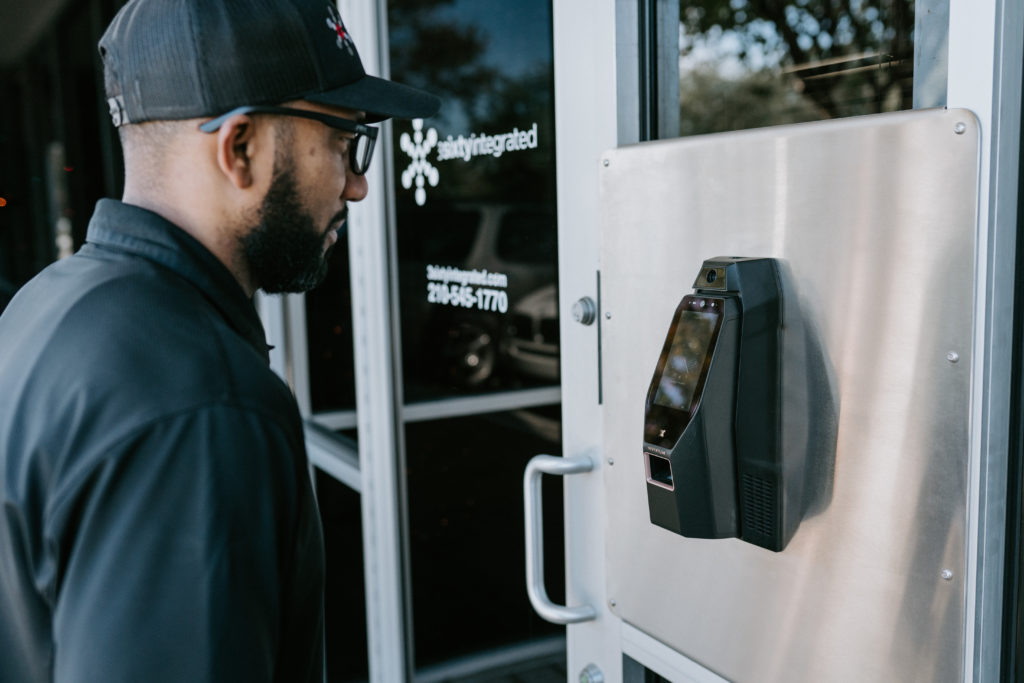
Over the past few years, electronic security trends have been focused on mitigating risks associated with the COVID-19 pandemic. If 2021 was the year of COVID-driven security solutions, 2022 will be all about addressing the “new normal.” While we are not out of the woods yet, organizations that make use of technologies with multiple applications will be the ones to find electronic security success.
Read on to see our picks for the electronic security trends that will have the most impact in 2022 and beyond.
1. Use of mobile credentials in access control will continue to rise
At the height of the pandemic, mobile credentials were billed as a great touchless access control solution, which they are, but mobile credentials offer numerous other benefits beyond being just touchless. Mobile credentials allow users to authenticate at a door using just their smartphone, effectively transforming a user’s phone into a more secure, convenient access card that is less likely to be lost or copied. While access cards and similar physical credentials, like key fobs and badges, are still the industry go-to, they come with costly implications.
Physical credentials are costly to produce, a pain to manage, and damaging to the environment. Furthermore, they are often lost and easily duplicated, creating greater risk of a security breach. A recent study shows that 41% of office workers use access cards to enter their office, yet the same amount of people said smartphones or smartwatches would be their first-choice credential. People don’t go anywhere without their smartphone, so while mobile credentials are a great no-touch solution to reduce the transmission of germs, their benefits span far beyond the pandemic.
2. Video analytics will mitigate new and ongoing risks
There are conceivably hundreds of video analytics available on the market today. When integrated with surveillance cameras, analytics offer companies valuable insights that would either cost a fortune to gather or simply are not within the realm of human capabilities. Analytics like people counting, face mask detection, and occupancy counting were marketed as a great way to help limit the spread of COVID, but there are so many other analytics on the market that can address a variety of other security and safety concerns. Take for example license plate recognition, slip and fall detection, loitering, and stolen object analytics.
The good news for end users is that analytics are only getting more accessible, smarter, and easier to use. “No-code” custom analytics, analytics that can be built using drag and drop tools, allow everyday people to create analytic solutions for their exact needs within minutes. Similarly, edge analytics offer faster data analyzing, allowing end users to make use of relevant data only without over-analyzing and massive storage needs. A great example of this technology in action is for in-hospital patient monitoring wherein real-time notifications are sent to healthcare administrators when unusual patient behavior is detected by cameras. This technology, that once seemed like a long way off, is usable today for those who are prepared for it.
3. Organizations will forego on-site deployments in favor of Cloud and hybrid solutions
The Cloud was certainly a buzzword used often in 2021, and for good reason. Solutions deployed in the cloud are accessible from anywhere where there is an internet connection, a big selling point during the work from home movement spawned by the pandemic. Electronic security solutions hosted on the cloud are able to be managed and updated remotely, potentially preventing an on-site visit from an integrator for a minor system update. Additionally, because cloud architecture allows for automatic updates and patches, they are often more secure than their on-site counterparts. In fact, a recent study found 52% of organizations surveyed said they found better security in the cloud than in on-premise IT environments.
The same study found that 87% of organizations experienced some business acceleration from their use of cloud services. The ability to deploy solutions offsite both saves storage and requires less labor, two important factors moving into the new normal in 2022. Even companies reluctant to move all their systems to the cloud can dip their toes in by using a hybrid solution consisting of a partial on-site and partial cloud deployment. Cloud-hosted visitor management, video management, and access control are all viable options to reduce human contact, but the additional benefits really take cloud solutions beyond the pandemic. Many providers in the security industry offer cloud-based management solutions to lessen their customers’ workloads and create more collaboration.
4. Innovations in organizational, sales, and operations software will help security integrators better address customer’s needs
There are a variety of software solutions on the market aimed at helping security integrators better serve their clients. These solutions help bridge the gap between a security integrator and their end user, a gap that has only widened throughout the pandemic. Take site-survey tools for example. When an integrator uses a virtual site-survey tool, they can collaborate and share a vision with their client, clearly outlining what their security solution will look like on-site while not actually being on site.
Innovative technologies like site-surveys, mobile apps for techs, inventory tracking, proposal creation, and more all deliver benefits to an integrator that they then pass on to their customers. The newfound efficiencies created by these tools are manifested to end users as better customer service, improved communications, and, in some cases, cost and time savings. In the future, security system users will start to demand more from their integrators, and rightfully so. Integrators will need to show transparency, willingness to collaborate, modern technology adoptions, etc. in order to provide value to their clients – something that can be accomplished via adoption of operational software.
5. Scalability of integrated technologies will remain key
Electronic security products and services like access control, visitor management, CCTV, and video management, all work better when they integrate seamlessly together. The more interoperability between systems, the more advantages and higher level of security an end user can expect. That is why the use of open architecture security devices, or devices that are compatible with other hardware and software, will only increase in the years to come. Ensuring integrated solutions meet a variety of needs, as opposed to just one, is better accomplished through interoperability.
The key will be vetting both the security integrator and the technology manufacturer to ask if the applicable solution is open, integratable, and, if so, with what technologies. A good security integrator will be able to tell you how to make the most of your investment for years to come. If you are unsure where to start, think of your core system as including video surveillance, access control, intrusion detection, and critical communications. These components should be 100% solid before introducing any additional technologies. Organizations need to pivot quickly to address new and ongoing risks, but can only do so if the foundation is solid.
6. Demand for unmanned electronic security solutions will grow
In order to address a workforce shortage, unmanned security solutions have grown in popularity. An example seen early in the pandemic was the use of automatic body temperature scanners that replaced manual temperature takers at business entrances. These solutions are less popular now, but the principle of unmanned solutions perseveres. Adoption of similar solutions will continue beyond the pandemic not only to address staffing shortages, but to lower an organization’s bottom line via reduced payroll, training time, etc.
This principle ties into remote security system management offered by some integrators. Having a trusted integrator as a partner to manage your security system allows you to streamline your security operations and increase bandwidth on your existing team. Why designate one of your own team members to oversee security management tasks when these duties can be regulated to your integrator, freeing your employee to tackle more important tasks? The more automated a security process and system becomes, the more added value for end users.
Conclusion
Moving into 2022, creativity will be the name of the game when it comes to electronic security. It is unknown when, and if, the pandemic will end, so organizations must be ready for anything. Those that can see beyond the surface level of solutions and find applications beyond the pandemic and the “now” will be able to future-proof their security deployments for years to come.
3Sixty Integrated is here to aid enterprise organizations across verticals develop viable security solutions that will allow key stakeholders to be protected 24/7. Our team can create customized security applications that will allow your organization to keep your assets safe and secure now and in the future. For more information, click here to schedule a short, 30-minute meeting or call us at (877) 374-9894.

